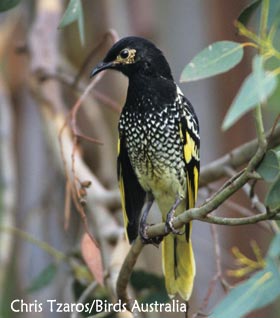This post comes from Sydney, Australia, where I am attending my niece’s wedding. Why a communication from here? Well, it happens that I have had an encounter with a particularly special bird, one that is featured in two of my books: 100 Birds to See Before You Die and the Atlas of Rare Birds. Three hours west of the city, the famous Capertee Valley regularly plays host to the gorgeous Regent Honeyeater, one of the continent’s rarest birds and one with a story to tell (see below).

- Regent Honeyeater
Having heard from local birders that some were around, I simply couldn’t resist a quick trip out there to try my luck. After quite an effort, I located one of these stunners along the Capertee River between Glen Davis and Glen Alice, among a big flock of Noisy Friarbirds. It was a pretty emotional moment. To get a flavour of its story, here’s a short extract from the Atlas.
“This is a bird with a formerly wide range over south-east Australia, including the states of Queensland, New South Wales, Victoria, South Australia and the Australian Capital Territory. In the early years of the 20th century it was frequently noted for its abundance. Flocks of hundreds of these striking and colourful birds with their loud ‘chinking’ calls were a regular sight in well-watered forests and gardens. There were occasional reports of thousands feeding from blooms of flowering gums, and there were times when large numbers would descend on orchards and cause serious economic damage. There seemed to be no serious ecological flaw that would make such a dominant bird become rare.
“And yet, from the 1940s onwards, the Regent Honeyeater did become increasingly less common. Nobody sensed trouble at first, though, because this was also quite a mysterious species. It would disappear from sites for a few years, only to return in large flocks when certain trees with reliable nectar bloomed in quantity. Outside the main season (September to November) it was always hard to find, and often impossible. However, after the 1940s one thing that birdwatchers did notice about Regent Honeyeaters was that the flocks were generally getting smaller: the hundreds, by and large, were becoming tens, and there were fewer flocks to count over the wide area that the honeyeater occupied. It wasn’t too long, though, before records began to dry up alarmingly. The last sighting from the state of South Australia, for example, was in 1977 – in an area where the Regent Honeyeater had once been abundant. There was also a serious drop in the number of reports from Queensland. Evidence of a slow but inexorable decline was beginning to emerge, a decline that had previously been masked by the bird’s nomadic habits and wide distribution.”
These days the surviving population numbers somewhere between 500 and 1,500 individuals, and it is continuing to drop. Birds are regularly seen in only four widely scattered locations, of which the Capertee Valley is one. To see one was a moment to treasure, albeit one tinged with concern for the fate of the bird itself.

I thought you weren’t going to get time to bird watch, but that search was well worth it.
What a fantastic trip. I have green eyes as I have never made it to Australia and have ticks missing from your book as a result.
Maybe one day but reading your adventures is a nice alternative.
All the best Mitch
Norways biggest fan 😉